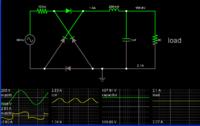- Joined
- Apr 1, 2011
- Messages
- 15,177
- Helped
- 2,899
- Reputation
- 5,810
- Reaction score
- 2,982
- Trophy points
- 1,393
- Location
- Minneapolis, Minnesota, USA
- Activity points
- 113,689
A simple LC circuit will provide regulation? Within 1 to 2%? can you kindly provide a source for this? I never heard of this before. As far as I know it provide a frequency filter action, and not regulation. Are you sure you are using the term correctly?
Sorry, I used the word regulation incorrectly. I meant that ripple is reduced to 1 or 2 percent.
